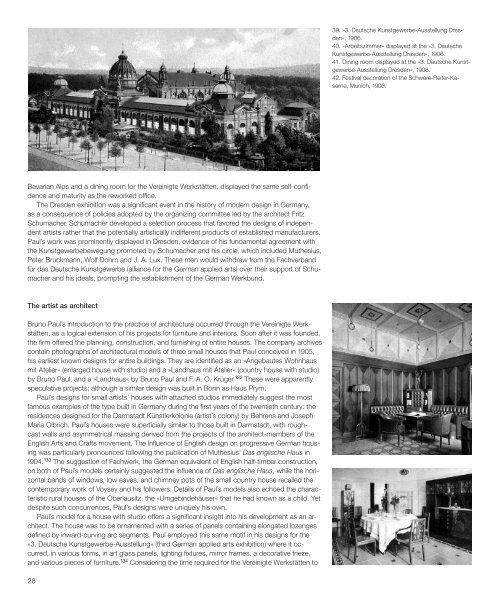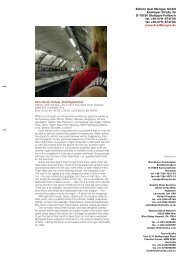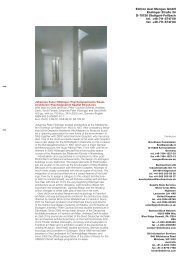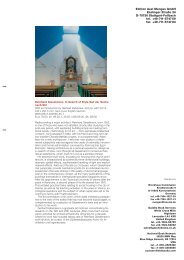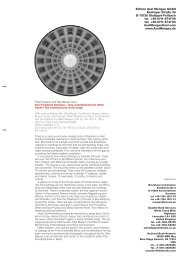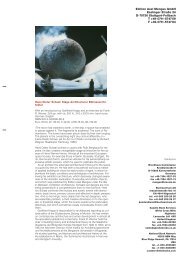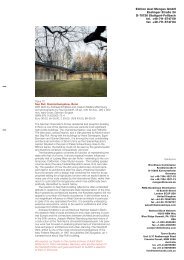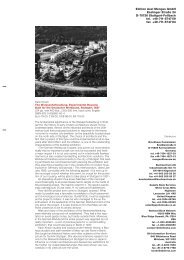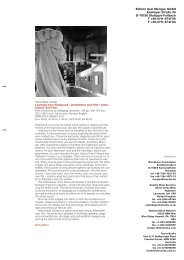Bruno Paul - Edition Axel Menges
Bruno Paul - Edition Axel Menges
Bruno Paul - Edition Axel Menges
Create successful ePaper yourself
Turn your PDF publications into a flip-book with our unique Google optimized e-Paper software.
Bavarian Alps and a dining room for the Vereinigte Werkstätten, displayed the same self-confidence<br />
and maturity as the reworked office.<br />
The Dresden exhibition was a significant event in the history of modern design in Germany,<br />
as a consequence of policies adopted by the organizing committee led by the architect Fritz<br />
Schumacher. Schumacher developed a selection process that favored the designs of independent<br />
artists rather that the potentially artistically indifferent products of established manufacturers.<br />
<strong>Paul</strong>’s work was prominently displayed in Dresden, evidence of his fundamental agreement with<br />
the Kunstgewerbebewegung promoted by Schumacher and his circle, which included Muthesius,<br />
Peter Bruckmann, Wolf Dohrn and J. A. Lux. These men would withdraw from the Fachverband<br />
für das Deutsche Kunstgewerbe (alliance for the German applied arts) over their support of Schumacher<br />
and his ideals, prompting the establishment of the German Werkbund.<br />
The artist as architect<br />
<strong>Bruno</strong> <strong>Paul</strong>’s introduction to the practice of architecture occurred through the Vereinigte Werkstätten,<br />
as a logical extension of his projects for furniture and interiors. Soon after it was founded,<br />
the firm offered the planning, construction, and furnishing of entire houses. The company archives<br />
contain photographs of architectural models of three small houses that <strong>Paul</strong> conceived in 1905,<br />
his earliest known designs for entire buildings. They are identified as an »Angebautes Wohnhaus<br />
mit Atelier« (enlarged house with studio) and a »Landhaus mit Atelier« (country house with studio)<br />
by <strong>Bruno</strong> <strong>Paul</strong>, and a »Landhaus« by <strong>Bruno</strong> <strong>Paul</strong> and F. A. O. Krüger. 132 These were apparently<br />
speculative projects; although a similar design was built in Bonn as Haus Prym.<br />
<strong>Paul</strong>’s designs for small artists’ houses with attached studios immediately suggest the most<br />
famous examples of the type built in Germany during the first years of the twentieth century: the<br />
residences designed for the Darmstadt Künstlerkolonie (artist’s colony) by Behrens and Joseph<br />
Maria Olbrich. <strong>Paul</strong>’s houses were superficially similar to those built in Darmstadt, with roughcast<br />
walls and asymmetrical massing derived from the projects of the architect-members of the<br />
English Arts and Crafts movement. The influence of English design on progressive German housing<br />
was particularly pronounced following the publication of Muthesius’ Das englische Haus in<br />
1904. 133 The suggestion of Fachwerk, the German equivalent of English half-timber construction,<br />
on both of <strong>Paul</strong>’s models certainly suggested the influence of Das englische Haus, while the horizontal<br />
bands of windows, low eaves, and chimney pots of the small country house recalled the<br />
contemporary work of Voysey and his followers. Details of <strong>Paul</strong>’s models also echoed the characteristic<br />
rural houses of the Oberlausitz, the »Umgebindehäuser« that he had known as a child. Yet<br />
despite such concurrences, <strong>Paul</strong>’s designs were uniquely his own.<br />
<strong>Paul</strong>’s model for a house with studio offers a significant insight into his development as an architect.<br />
The house was to be ornamented with a series of panels containing elongated lozenges<br />
defined by inward-curving arc segments. <strong>Paul</strong> employed this same motif in his designs for the<br />
»3. Deutsche Kunstgewerbe-Ausstellung« (third German applied arts exhibition) where it occurred,<br />
in various forms, in art glass panels, lighting fixtures, mirror frames, a decorative frieze,<br />
and various pieces of furniture. 134 Considering the time required for the Vereinigte Werkstätten to<br />
39. »3. Deutsche Kunstgewerbe-Ausstellung Dresden«,<br />
1906.<br />
40. »Arbeitszimmer« displayed at the »3. Deutsche<br />
Kunstgewerbe-Ausstellung Dresden«, 1906.<br />
41. Dining room displayed at the »3. Deutsche Kunstgewerbe-Ausstellung<br />
Dresden«, 1906.<br />
42. Festival decoration of the Schwere-Reiter-Kaserne,<br />
Munich, 1906.<br />
execute <strong>Paul</strong>’s contributions to the Dresden exhibition, it is likely that he was designing them in<br />
parallel with the preparation of his model houses. At the time he was clearly interested in a formal<br />
vocabulary that he employed, with equal facility, in a variety of artistic media. This practice again<br />
recalls the ideal of the Gesamtkunstwerk, the artistic synthesis characteristic of the Jugendstil<br />
that was a central theme in <strong>Paul</strong>’s early work as an applied artist.<br />
<strong>Paul</strong>’s first published architectural project was even more closely related to his interior designs<br />
than his apparently unexecuted series of artist’s houses. In 1906, he received a commission to<br />
decorate the stark façades of the Munich barracks of the heavy cavalry regiment »Prinz Karl von<br />
Bayern«, the Schwere-Reiter-Kaserne, for a visit by Kaiser Wilhelm II. <strong>Paul</strong> adapted another of the<br />
motifs he had employed in Dresden, that of an orthogonal grid interrupted by a single lozenge as<br />
a focal element, in the wooden architectural ornaments that he conceived for the barracks. The<br />
effect of his ornaments, installed like pilasters against the smooth façade of the existing building<br />
and adorned with ribbons and garlands, was soberly festive, monumental, and classical. 135<br />
When Wilhelm II arrived in Munich on 12 November, he found <strong>Paul</strong>’s decorations very much to<br />
his liking. According to <strong>Paul</strong>’s recollection, the Kaiser halted his motorcade as it passed the barracks<br />
and personally commended the designer. 136 Despite the satires on the official taste of the<br />
Hohenzollern monarchy that regularly appeared in the pages of Simplicissimus, the Kaiser himself<br />
maintained an educated interest in architecture. 137 His admiration for <strong>Paul</strong>’s work illustrates the<br />
extent to which the artist had engaged the aesthetic sensibilities of mainstream culture. Notwithstanding<br />
the inherent irony of the meeting between the autocratic sovereign and the Simplicissimus<br />
illustrator, <strong>Paul</strong>’s brief reception by Wilhelm II in 1906 facilitated his appointment to a professorship<br />
in Berlin the following year.<br />
A new direction<br />
By 1906, <strong>Bruno</strong> <strong>Paul</strong> had emerged as one of the most prominent modern artists in Central Europe.<br />
His fame had been established through his illustrations for Simplicissimus, published over<br />
the span of a decade. The vibrant cultural milieu of turn-of-the-century Munich that had provided<br />
Simplicissimus with its creative vitality inspired <strong>Paul</strong> to explore the limits of his own artistic abilities.<br />
He continued to draw and paint, but also designed metalwork, furniture, textiles, and entire interiors<br />
for the Vereinigte Werkstätten für Kunst im Handwerk for which he received international acclaim.<br />
As an applied artist, <strong>Paul</strong> contributed to the definitive character of the Jugendstil, and then<br />
to its transcendence. In 1906 his work was increasingly cited as a harbinger of a new direction in<br />
German design. <strong>Paul</strong>’s designs for furniture and interiors ultimately led him to architecture, a discipline<br />
in which all of his interests could be conjoined. His first executed commissions demonstrated<br />
his natural talent for design on an architectural scale.<br />
Despite his splendid accomplishments, <strong>Paul</strong> had never realized the objective that had brought<br />
him to Munich as a student. He had not become one of the »Malerfürsten« of the city, and it was<br />
obvious that he never would. Characteristically, he confronted this realization by seeking a new<br />
challenge towards which to apply his restless intellect. <strong>Paul</strong> was ready to leave Munich when an<br />
opportunity arose in 1906.<br />
28 29


